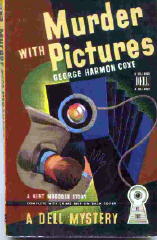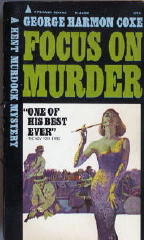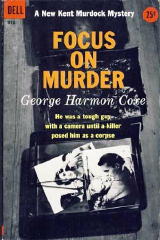Wed 6 Aug 2008
Archived Review: GEORGE HARMON COXE – Focus on Murder.
Posted by Steve under Authors , Characters , Reviews[6] Comments
GEORGE HARMON COXE – Focus on Murder.
Pyramid R-1259; reprint paperback; 1st printing, January 1966. Cover by Frank Kalan. Hardcover edition: Alfred A. Knopf, March 1954. Hardcover reprint: Dollar Mystery Guild, June 1954. Previous paperback reprint: Dell 970, 1958.

What with two paperback editions and (more importantly) a book club edition, this is not a difficult book to find, if you all you want to do is to have one to read.
In his prime, if Coxe was not a bestselling author like Gardner and Christie, his sales must have been steady if not spectacular, as his career in hardcovers began in 1935, with Murder with Pictures (with Kent Murdock) and did not end until No Place for Murder in 1975 (not with Kent Murdoch, but with PI Jack Fenner, who also appeared in that very first book).
Here’s something interesting. While Jack Fenner appeared in 12 cases chronicled by Coxe, his only solo appearance was that last one, which appeared when the author was 74. (Coxe himself lived another nine years, until 1984.)
Coxe is probably best known for his series character “Flashgun” or “Flash” Casey, a tough Boston-based news photographer who began his crime-solving in the pages of Black Mask magazine, circa 1934, but (after a quick double-check to confirm this) he wrote far many more novels in which Boston-based news photographer Kent Murdock appeared (23) than those in which Casey was the detective of record (only five).

The difference in fame, relatively speaking, is probably due to the fact that Casey had a long-running radio show named after him, and two movies based on his exploits, while Murdock had neither.
Kevin Burton Smith over at his Thrilling Detective website suggests that Murdock is Casey with the rough edges smoothed off. Given Casey’s early pulp fiction days, he is probably quite correct in that assessment. Since their paths seem to have never crossed, that only adds credence to a hypothesis that one was really the alter ego of the other (and therefore could not appear in the same book at the same time).
Whatever. Although his roots were definitely in the pulps, I would still consider Coxe as an author solidly in the detective story tradition of the so-called Golden Age. If you do indeed come across a copy of this book, and if my review and other chatter convinces you to read it as well — which I certainly am attempting to do — be sure to strap yourself in for a fast-paced sequence of action and clues which you’ll have to keep your eyes on every minute of the way.
Let’s get the basic story line out of the way first. A colleague of Murdock’s at the Courier is found murdered shortly in his apartment after his (Murdock’s) departure, said colleague (as it turns out) having been a blackmailer in his spare time. That Murdock happened to have been in Ralph Stacy’s place of residence is important but not significant in the sense that he becomes one of the suspects –Lt. Bacon has worked with Casey before, and I’ll get back to this in a moment — but (as it turns out) an entire parade of suspects was in and out of the apartment and/or lurking around the building both before and after Murdock comes on the scene.

There is nothing like good old-fashioned (and dirty) blackmail to create a long list of such suspects, not to mention a wife who has just moved out, a current girl friend and a close boy friend of said girl friend, who just happens to be the jazz singer shown on the cover. Murdock is also personally offended by the murder in a personal sense, being a true-blood newspaperman through and through, nor can the reader help be offended as well.
Coxe also had an excellent insight into the way people in the real world (mostly male, I concede) react to tragedy and other things, which includes matters of right versus wrong, in a strangely tweedy sort of way. He also seems to have been quite the jazz aficionado. I won’t quote Murdock’s conversation with pianist Jack Frost about Art Tatum on page 80 — it’s rather long — but there is nothing said here about Tatum that anyone could possibly dispute.
By page 116, Lt. Bacon has (figuratively) thrown up his hands and asks Murdock, quite unofficially of course, to give him (Bacon) whatever assistance he (Murdock) can. And of course he (Murdock) does, again with neither the final flourish of a Christie or a Gardner (to pick a couple of prime examples) out of the air, but with the somewhat subdued manner of a magician whose apparent casualness catches you blinking, with the sudden understanding of just how easily the unwary reader (me, this time) can be taken in.
[UPDATE] 08-06-08. Well, as you can see, whatever reservations I had about Coxe’s plotting abilities in One Hour to Kill were completely non-existent in this Kent Murdock mystery published some ten years earlier. I’ll really have to read that other book again, as I simply can’t tell you if I was really as hard on it then as I’m reading into my own review of it now.
Other the other hand, I’ve just finished Fashioned for Murder (from 1947), and I didn’t find a whole lot to be happy about at all. (This is what prompted my going back and digging out these earlier two reviews.) I’ll get my review of it posted soon, but of course I will have to write it first.
August 6th, 2008 at 10:30 pm
I used to like Coxe’s work quite a bit, but the last two novels I’ve read by him were pretty slow going. However, they were non-series books. The last Kent Murdock novel I read, admittedly a few years ago, was just fine, though.
August 6th, 2008 at 11:30 pm
A number of authors seem to abandon their series characters once they begin to tire of them — which I can certainly relate to — starting with Doyle and Holmes.
But also sometimes (not always) their non-series books lack something their series characters provided, and that’s their previously established personalities that the books they’re in can rely on for easy reader recognition and (even better) a solid foundation from the very start.
It’s a premise, that’s all, with lots of counterexamples that I’m sure will come to me as soon as I hit “submit.”
— Steve
August 8th, 2008 at 11:05 am
Steve,
These were really interesting articles on George Harmon Coxe!
I’ve never read any of the Coxe books reviewed here. Will be trying to track down a copy of “Focus on Murder”, pronto.
Coxe is such a frustratingly uneven writer, as your reviews point out. He’s written books good, bad and indifferent. I’ve never seen anything like a career survey of his vast output, highlighting what is best among his books and short stories.
Mike
August 8th, 2008 at 11:42 am
Many thanks, Steve.
The George Harmon Coxe reviews and views and responses are fascinating. An author I’ve always been aware of yet, rather shamefully, one that I have not yet read. I am aware, however, of his big and small screen associations. (Which doesn’t mean that I have seen most of these either.)
But if several of the following films and TV work were easily available, I’m sure there would be much pleasure to be had in the viewing (or at least, the experience). While one can respect and appreciate that viewing screen adaptations of any author’s work is not the same as experiencing the original art of the written word, there remains with me a certain fascination of how the literary concept is translated into a (albeit condensed) visual storytelling form. An art in itself, of course.
Research shows that the following have Coxe credentials (in one form or another) and are worthy of further investigation. Well, some of them, perhaps…
Women in Trouble (1936, d. Errol Taggart). With Stuart Erwin as Matt Casey, a newspaper reporter following up a series of robberies and murders. Screenplay by producer Michael Fessier, from story by GHC.
Murder With Pictures (1936, d. Charles Barton). Lew Ayres is Kent Murdock in a plot that kicks off with the murder of a gangland lawyer. Screenplay by John C. Moffitt and Sidney Salkow, from story by GHC.
The Shadow Strikes (1937, d. Lynn Shores). Based on the story ‘The Ghost of the Manor’ by Maxwell Grant in The Shadow (15 June 1933). Rod La Rocque as Lamont Cranston. Screenplay by Al Martin, from adaptation by Martin, Rex Taylor and GHC. Intended by producer Colony Pictures to be the first of four ‘Shadow’ films.
Here’s Flash Casey (1937, d. Lynn Shores). Based on the short story ‘Return Engagement’ by GHC in Black Mask (March 1934). Eric Linden is Flash Casey. Screenplay by John Krafft.
Arsene Lupin Returns (1938, d. Geo. Fitzmaurice). Silky Melvyn Douglas was the silky Arsene Lupin. Based on characters created by Maurice Leblanc, the story and screenplay was by James Kevin McGuinness, Howard Emmett Rogers and GHC.
The Hidden Eye (1945, d. Richard Whorf). Based on the novel The Last Express (1937) by Baynard Kendrick. Screenplay by GHC, Harry Ruskin, from story by GHC. One of the two pleasing MGM Captain Duncan Maclain films starring Edward Arnold (the other being Eyes in the Night, 1942).
For the home screen, there was Crime Photographer (CBS, 1951-52) featuring Richard Carlyle (brief stint, 1951) and Darren McGavin (1951-52) as Casey of The Morning Express.
‘The Category is Murder’ (1957) for Kraft Television Theatre (NBC), about a TV quizmaster who drops dead of poisoning during a show. Betsy Palmer and Gene Lyons featured. And that’s about all I know about this one. GHC as teleplay or story source…?
‘Focus on Murder’ (1958, d. Bill Corrigan) for Kraft Television Theatre featured Si Oakland as Kent Murdock in a story about a Pulitzer Prize reporter found murdered in his apartment. Mel Goldberg adapted from novel by GHC.
‘Mission of Fear’ (1963, d. Harvey Hart) for U.S. Steel Hour (CBS) involved the statuesque Salome Jens and Robert Horton in a blackmail story written by Richard F. Stockton [from story/source by GHC…?].
A list of credits without benefit of personal insight or opinion can be somewhat dreary, I know, but I have not been fortunate enough to view most of the above titles, especially the rare TV work. Perhaps others with more opportune moments of viewing access may offer a more satisfying sense of form and flavour.
For my part, it is hoped that I have viewing pleasures to look forward to…one day.
Best Regards,
Tise
Women in Trouble (1936
May 17th, 2009 at 3:33 pm
[…] relate to — starting with Doyle and Holmes,” says Steve Lewis in a [comment to a] post at his wide-ranging Mystery*File […]
August 14th, 2010 at 8:50 pm
[…] COXE in the Movies and on TV (by Tise Vahimagi) Fashioned for Murder (reviewed by Steve Lewis) Focus on Murder (reviewed by Steve […]